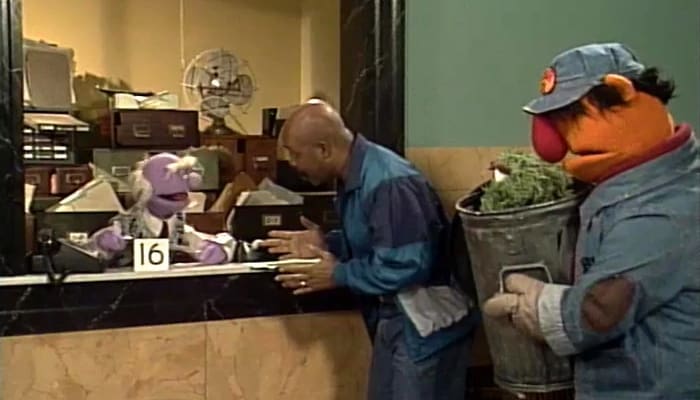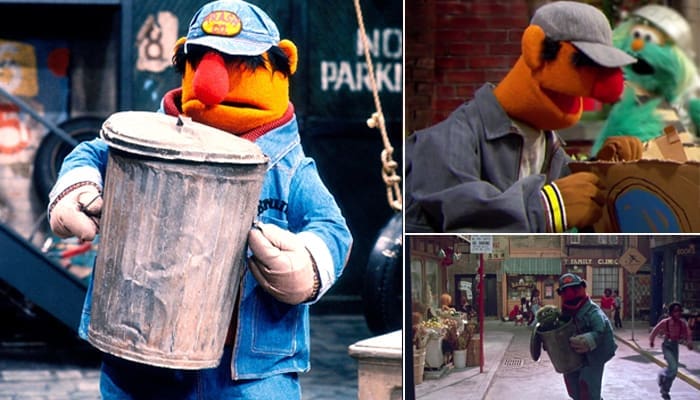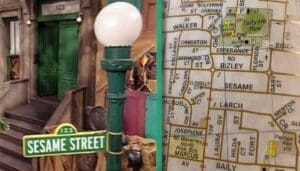Remembering a Gentle Giant of Sesame Street
Think back to the Sesame Street of yesteryear – a vibrant, bustling neighborhood teeming with life. The familiar brownstone stoop, the friendly faces of human neighbors, and the unforgettable cast of Muppets created a world that felt both magical and real. Beyond the feathered yellow giant and the perpetually grumpy resident of the trash can, the Street was populated by a host of characters who added depth and texture to this unique urban landscape. Their consistent presence, even without fanfare, helped build the rich tapestry that captured generations of young viewers. When such figures disappear, long-time watchers might sense a subtle shift, a feeling that something familiar is missing, highlighting how deeply audiences connect with the show’s entire atmosphere. One such figure, often seen but rarely heard, was Bruno the Trashman, the large, silent sanitation worker forever linked with Oscar the Grouch. Many might recall his imposing form, faithfully carrying Oscar’s can, but his story, his unique contribution, and the reasons for his absence are worth revisiting. As nostalgia for classic Sesame Street endures, it’s time to celebrate Bruno, understand his quiet significance, and explore why this gentle giant deserves a return route to the most famous street on television.
Meet Bruno: Oscar’s Strong, Silent Chauffeur
Bruno the Trashman cut a distinct figure on Sesame Street. He was a large, full-body Muppet, costumed in the practical attire of a sanitation engineer. His sheer size suggested considerable strength, a necessary attribute given his primary function: acting as Oscar the Grouch’s personal, mobile transport unit. Bruno was most often seen diligently carrying Oscar’s trash can, with Oscar nestled inside, allowing the neighborhood’s resident Grouch to participate in activities beyond his usual stationary spot. Described as Oscar’s friend and “personal chauffeur,” Bruno provided a unique form of mobility for the can-bound character.
The genius behind Bruno, however, extended beyond his on-screen role. His existence was a masterstroke of practical puppetry conceived by the legendary Caroll Spinney, the performer who brought both Big Bird and Oscar the Grouch to life for nearly five decades. During the 1970s, as the Sesame Street cast undertook live performance tours, Spinney faced a logistical challenge: how could Oscar effectively enter the stage or move around outdoor sets while Spinney was performing him? Inspired by another full-body puppet character, Spinney designed Bruno as an ingenious solution. Bruno was a full-body costume that Spinney himself wore, allowing him to operate the Oscar puppet from inside the Bruno suit, effectively hiding in plain sight. Special openings were built into Bruno’s stomach area and the back of the trash can, allowing Oscar to emerge and interact.
This practical necessity directly shaped Bruno’s defining characteristics. To free Spinney’s hands to operate Oscar’s body and left arm, Bruno’s own large, gloved hands were typically attached directly to the handles of the trash can he carried. Furthermore, the complexity of having one performer operate two characters simultaneously meant that giving Bruno dialogue was impractical. Thus, Bruno became the strong, silent type – a character defined by his physical presence and actions rather than words. His fixed hands and usual silence weren’t arbitrary traits but clever adaptations born from the need for Spinney to perform Oscar effectively while remaining unseen. This interplay between behind-the-scenes requirements and on-screen persona resulted in a unique and memorable character, a testament to the creative problem-solving inherent in Muppet production. Although predominantly silent, an invisible wire was sometimes attached to Bruno’s mouth, allowing it to open for rare occasions, hinting at a voice held in reserve.
Bruno the Trashman: Quick Facts
| Feature | Detail |
|---|---|
| Role | Oscar the Grouch’s trash can carrier / mobile unit |
| Appearance | Large, full-body Muppet dressed as a sanitation worker |
| Years Active | c. 1979 – 1993 (primary tenure) |
| Performer | Caroll Spinney (primarily, inside suit operating Oscar) |
| Key Trait | Mostly non-speaking; strong physical presence |
| First Appearance | Episode 1259 |
Bruno’s Time on the Street (c. 1979-1993)

Bruno the Trashman was a regular fixture on Sesame Street for over a decade, primarily appearing between 1979 and 1993. His debut is cited as Episode 1259, placing his arrival in the late 1970s, consistent with Spinney’s need for a mobile Oscar solution for touring. While his main function was practical, Bruno wasn’t merely a prop; the show’s writers occasionally gave him moments that showcased unexpected skills or placed him in humorous situations, demonstrating that they saw potential beyond his role as Oscar’s transport.
One of Bruno’s most high-profile appearances was in the 1985 feature film Follow That Bird. His inclusion in this major cinematic outing cemented his place within the wider Sesame Street universe beyond the daily television show. On the show itself, a particularly memorable segment occurred during the 1991 special “Big Bird’s Birthday, or Let Me Eat Cake”. In this episode, the Sesame Street gang goes roller-skating. Bruno joins in, impressively gliding along while still carrying Oscar in his can. Oscar, true to his nature, hoped Bruno might stumble or cause a comical collision, but was instead disappointed by Bruno’s skillful skating, while the human characters looked on amazed. This scene not only provided physical comedy but also subtly highlighted Bruno’s hidden talents and gentle competence, themes echoed in the show’s general encouragement songs like “Don’t Give Up” which often featured activities like learning to skate.
Bruno also served as the silent recipient of one of Oscar’s classic tunes, “Trash Outta Heaven”. In this Season 15 song, Oscar sings directly to Bruno, sharing his grouchy fantasy of a world where trash rains from the sky. This interaction underscored their unique dynamic – Bruno as the stoic, patient audience for Oscar’s eccentricities. Further reinforcing his role in Oscar’s mobility, Bruno was shown carrying the trash can while jogging around the block with Oscar and others during morning exercises in a 1981 episode segment.
Perhaps the most surprising Bruno moment, however, occurred in a sketch where he appeared without Oscar. He featured as the bass singer for a doo-wop group aptly named “Bruno and the Trashmen”. Performing the song “In the Trash Can,” Bruno not only provided vocalizations (likely using the aforementioned wire mechanism for mouth movement) but also collected garbage thrown by the other singers in a specially decorated, sparkly trash can. This rare spotlight moment played delightfully against his usual silent, supporting role, showcasing a flash of unexpected personality and stage presence. These specific instances demonstrate that while Bruno’s existence served a practical purpose, he was occasionally allowed to step out of the background, becoming more than just scenery and hinting at a character with untapped potential.
The Mystery of the Missing Trashman: Why Bruno Vanished
After more than a decade of faithfully carrying Oscar around the Street, Bruno the Trashman quietly disappeared from regular appearances around 1993. His departure wasn’t marked by any specific storyline or fanfare; he simply stopped showing up. For fans who grew up watching him, his absence left a subtle void in the familiar landscape of the show.
The reason behind Bruno’s vanishing act was, ultimately, quite mundane, rooted in the physical realities of puppetry and production. According to reports, the complex, full-body Bruno costume simply wore out over time. Constant use, the stress of carrying the Oscar puppet and mechanism, and likely the effects of storage took their toll, leading the suit to deteriorate.
When Caroll Spinney reportedly inquired about Bruno’s absence, he was informed that the character had disintegrated in storage. Crucially, the producers deemed the cost of rebuilding the large, intricate costume to be prohibitively expensive. This highlights the practical, financial considerations that underpin television production, even for a beloved institution like Sesame Street. Full-body Muppet costumes represent a significant investment in materials and craftsmanship. The decision not to rebuild Bruno suggests that, at that particular time in the early 1990s, the resources required were prioritized elsewhere. Perhaps alternative, simpler methods for making Oscar mobile, such as having puppeteers’ legs clad in green fur protrude from the bottom of the can, were considered sufficient. Bruno’s fate serves as a reminder that character longevity on screen can sometimes depend as much on material condition and budget allocation as on popularity or narrative choices. His departure wasn’t a creative rejection, but a practical hurdle. Though largely absent since the early 90s, a nod to the character reportedly occurred in 2016, when he briefly reappeared as a hand puppet easter egg, a small acknowledgment for long-time fans but not a full return.
The Unsung Value of Bruno
Though born from practical necessity, Bruno the Trashman brought several unique and valuable qualities to the Sesame Street neighborhood during his tenure. His specific characteristics contributed subtly but significantly to the show’s diversity and representation.
Firstly, Bruno stood out as a prominent non-speaking character. In a show filled with chatter, songs, and lessons delivered through dialogue, Bruno communicated entirely through his actions and presence. This offered a different model of interaction for young viewers, implicitly validating non-verbal communication and encouraging observation of physical cues and relationships. His silence wasn’t emptiness; it was a defining trait that set him apart.
Secondly, his very identity as a “Trashman” or “Sanitation Engineer” provided representation for an essential, yet often overlooked, community helper role. Bruno embodied physical labor, the kind of vital work that keeps communities functioning but doesn’t always receive recognition. His presence visually reinforced the value of different kinds of jobs within the neighborhood ecosystem.
Visually, Bruno added to the diversity of Muppet forms on the Street. As one of the relatively few full-body Muppets, he offered a different scale and physical presence compared to the more numerous hand-and-rod puppets. Standing alongside Big Bird and Mr. Snuffleupagus, he contributed to a richer visual tapestry.
Furthermore, Bruno embodied an interesting juxtaposition of strength and gentleness. His ability to constantly carry Oscar’s can – canonically larger on the inside and containing numerous items – implied immense physical power. Yet, his demeanor was consistently passive, patient, and non-threatening. He was the strong, silent helper, a gentle giant performing his duty without complaint.
Finally, his relationship with Oscar, while unconventional, represented a form of teamwork and support. Bruno enabled Oscar, the ultimate non-conformist, to participate more fully in the life of the Street, demonstrating a quiet form of accommodation and partnership. Through these combined attributes, Bruno subtly enriched the show’s curriculum, touching on themes of community roles, diverse communication styles, and the dignity of labor, simply by being himself. His absence removed this particular blend of quiet representation from the Street’s daily life.
“Bring Back Bruno!”: Fan Nostalgia and Appreciation
Despite his long absence from Sesame Street, Bruno the Trashman has not been entirely forgotten. Evidence suggests a lingering fondness and appreciation among fans, particularly those who grew up watching the show during the 1980s and early 1990s. This enduring affection manifests in various ways, demonstrating that Bruno still holds a place in the collective memory of Sesame Street viewers.
Online forums and comment sections occasionally feature discussions where Bruno is mentioned with nostalgia. Comments on Muppet fan blogs explicitly call for his return, sometimes from younger fans who know him only through older clips but appreciate his unique role. Reddit threads discussing Muppets or nostalgia sometimes reference Bruno, indicating continued awareness and recognition within fan communities. While perhaps not widespread, these mentions signal that he hasn’t faded completely from view.
More active forms of appreciation also exist. Fans have dedicated time and effort to creating tributes to Bruno. There are accounts of individuals creating and wearing Bruno the Trashman cosplay costumes, even getting the chance to meet Caroll Spinney while dressed as the character. Online videos demonstrate fans crafting their own DIY Bruno costumes, showcasing a dedicated level of engagement. Furthermore, custom-made Bruno figures, styled after classic toy lines like Fisher Price Little People, have been created and sold, suggesting a desire among collectors for physical representations of the character.
The persistence of Bruno in merchandise, even years after his regular appearances ceased, also speaks to his recognizability. Platforms like Zazzle offer licensed Sesame Street products featuring Bruno alongside Oscar, including greeting cards, t-shirts, and wooden box signs. The existence of such items suggests that Sesame Workshop or its licensees recognize that Bruno still has appeal and marketability.
This continued interest in Bruno is deeply intertwined with the powerful force of nostalgia. Childhood connections to media like Sesame Street often create lasting emotional bonds. Characters like Bruno, who were part of the familiar backdrop during a specific era, become integral pieces of those cherished memories. The calls for his return, the fan creations, and the purchase of merchandise are all expressions of this nostalgic affection – a desire to reconnect with a beloved part of the past. It indicates a genuine, if perhaps niche, audience sentiment that values Bruno’s contribution to the show’s history.
Making the Case: Why Bruno Belongs on Modern Sesame Street
The fondness fans hold for Bruno the Trashman isn’t just about looking backward; it forms the foundation of a compelling case for his return to the modern Sesame Street landscape. Bringing back this gentle giant offers opportunities to connect with the show’s legacy, enhance its diversity, and engage with contemporary themes in meaningful ways.
Firstly, acknowledging and occasionally reviving characters like Bruno taps into the powerful nostalgia felt by viewers who grew up with him. It serves as a nod to the show’s rich history and can create moments of intergenerational connection, allowing parents who remember Bruno to share that piece of their childhood with their own kids. It reinforces the idea of Sesame Street as an enduring world with a long and varied past.
Secondly, Bruno’s return would enhance the show’s diversity in several unique ways. He would bolster the ranks of the less common full-body Muppets, adding visual variety to the Street scene. His non-verbal nature remains a valuable form of representation, offering a model for meaningful interaction and contribution that doesn’t rely on speech – an important concept in a diverse world. Furthermore, explicitly reintroducing him as a sanitation worker allows the show to continue celebrating essential community helpers, highlighting the dignity and importance of physical labor roles.
Most significantly, Bruno is perfectly positioned to contribute to modern Sesame Street’s educational goals, particularly concerning environmental responsibility. As a trashman, he has an intrinsic connection to themes of waste management, recycling, and caring for the environment – topics frequently explored in contemporary children’s programming. Imagine Bruno patiently sorting recyclables, perhaps even trying to teach Oscar the difference between trash and compost (likely much to Oscar’s loud objections). He could become the friendly, silent face of “going green” on the Street, transforming his original role into one with direct relevance to today’s curriculum. This provides a natural, character-driven way to explore these vital lessons, potentially creating new, humorous dynamics with Oscar and other residents. His inherent connection to waste management offers significant, untapped potential for purposeful storytelling.
Of course, the irreplaceable Caroll Spinney, Bruno’s originator, is no longer with us. However, Sesame Street has a strong history of successfully transitioning legacy characters to new performers. Eric Jacobson, for instance, now performs Oscar the Grouch, carrying on Spinney’s legacy. A skilled, sensitive puppeteer could undoubtedly learn the unique physical requirements of performing Bruno, potentially even finding opportunities to subtly develop his character further while honoring his silent roots. The practical hurdle that led to his departure – the deteriorated suit – could surely be overcome with modern puppet-building techniques and a renewed commitment to the character.
Conclusion: Give Bruno Another Route on Sesame Street
Bruno the Trashman occupies a unique space in the annals of Sesame Street. He was more than just Oscar the Grouch’s mode of transport; he was a feat of puppeteering ingenuity, a gentle giant representing silent strength and essential community work. Born from Caroll Spinney’s practical need to make Oscar mobile, Bruno became a quiet yet memorable presence on the Street for over a decade.
His disappearance, stemming from the physical decay of his costume and the cost of rebuilding, left a subtle gap in the show’s fabric. Yet, fan nostalgia keeps his memory alive, evidenced by online discussions, fan creations, and even current merchandise. This enduring fondness, combined with Bruno’s inherent potential, forms a strong argument for his return.
Bringing Bruno back wouldn’t just be a sentimental gesture. It would enhance the show’s representational diversity through his non-verbal communication and full-body form, and by celebrating the vital role of sanitation workers. Crucially, his character offers a natural and engaging way to explore pressing contemporary themes like environmental responsibility, recycling, and community care. He isn’t merely a relic of the past; he has untapped potential to contribute meaningfully to Sesame Street’s present and future mission. While the original performer is gone, the spirit of innovation that created Bruno in the first place can surely find a way to bring him back. Isn’t it time Bruno the Trashman found his route back to Sesame Street?




![Read more about the article [Poll] Which Muppet Deserves Their Own Spin-Off Show?](https://b3955929.smushcdn.com/3955929/wp-content/uploads/2025/02/vote-for-muppet-300x171.jpg?lossy=2&strip=1&webp=1)